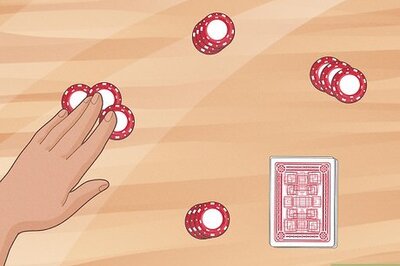
views
The Donald Trump administration has been at it for a while now. Silicon Valley and tech companies operating in the US have been in the line of what seemed to be persistent fire of the US administration over the Trump presidency. One decision after the other, one tweet after the other, and it seemed like President Trump was doing exactly what people who have no knowledge about technology often do—be seen trying to take an interest and poking everything they aren’t supposed to, while not thinking of the repercussions. That’s fine for friends and relatives to do the clueless thing when it comes to technology, perhaps not so much for the US President. Many political watchers believe that the Trump administration has left the new Joe Biden administration with a lot of work to do to, not just in terms of policy but also with Silicon Valley in the US and Chinese tech companies as well.
It all started out in what seemed to be a pretty neat way, akin to a senior citizen in your family seamlessly learning how to use WhatsApp and then can’t stop talking about it. Trump formed the American Technology Council in 2017 and regularly interacted with Silicon Valley bigwigs. But when in the summer of 2017, Trump announced that the US was pulling out of the Paris Climate agreement that includes almost 200 more countries, tech companies took a stand. Apple, Microsoft and Google were among the first to reaffirm their support for the climate agreement and said they’d continue to follow the terms in their business operations. Tesla’s Elon Musk quit the aforementioned Council at this time.
Trump’s Action Against Xiaomi: While Trump vs Huawei is something that we are all pretty much abreast with, just a few days ago, the administration blacklisted Chinese tech company Xiaomi as well for alleged military links with the China National Offshore Oil Corp. over the drilling in the South China Sea. “The Company reiterates that it provides products and services for civilian and commercial use. The Company confirms that it is not owned, controlled or affiliated with the Chinese military, and is not a “Communist Chinese Military Company” defined under the NDAA. The Company will take appropriate course of actions to protect the interests of the Company and its shareholders,” a Xiaomi spokesperson had told News18 hours after the announcement was made. This is a saga that is ongoing, something that the Joe Biden administration will have to tackle.
Also Read: US Dept of Justice Blacklists Xiaomi, But Will It Affect The Indian Market? Here’s What We Know
Huawei Ban And The Second Kick In The Gut: The latest and possibly chapter of the Donald Trump administration’s actions against Chinese tech company Huawei sees the revoking of licenses of suppliers to work with the Chinese company. The list includes tech giant Intel. Till now, Intel was among the small group of companies allowed to do business with Huawei. The saga started in 2019 when the Trump administration put Huawei on the so-called entity list, which meant the company was considered a threat to national security. It is believed that Huawei allows access to the Chinese government via backdoors in its software, particularly in telecom equipment. The company has consistently denied these allegations. Trump’s order meant that Huawei no longer had access to Google’s Android operating system for their smartphones. Huawei has meanwhile returned solid numbers. The revenues for the Chinese tech company were 9.9% higher than the year before while generating $100 billion in revenue in the first three quarters of 2020.
Also Read: Ahead of Biden’s Oath, Trump Pushes Final Blow to Huawei through Halt on Suppliers
The 5G Network That Never Happened: The Trump administration had two sides to the coin—the deep mistrust for China and the attempt to push American businesses. Neither always worked out well. In June 2018, the Trump administration proposed the idea of a nationwide and nationalized 5G network, in an attempt to counter a 5G network that may have components from Chinese tech companies. Pretty much everyone with any idea of how things work, shot down the idea. Including the Federal Communications Commission (FCC) commissioners. it was also roundly criticised by fellow Republican Commissioner Michael O-Reilly who said the idea was “nonsensical”. That was the last we heard of it.
Google, Apple, Tesla And Big Tech Unimpressed by Immigration Crackdown: When Donald Trump signed an executive order to launch an immigration crackdown in the summer of 2020, suspending foreign work visas including H-1B and L-1, tech companies including Apple, Google and Tesla were among the first to criticize the move.” Like Apple, this nation of immigrants has always found strength in our diversity, and hope in the enduring promise of the American Dream. There is no new prosperity without both. Deeply disappointed by this proclamation,” said Apple CEO Tim Cook. “Immigration has contributed immensely to America’s economic success, making it a global leader in tech, and also Google the company it is today. Disappointed by today’s proclamation — we’ll continue to stand with immigrants and work to expand opportunity for all,” said Google’s Sundar Pichai on Twitter.
This wasn’t the first time. In September 2017, Trump administration announced plans to end the Deferred Action for Childhood Arrivals program (DACA) which protected undocumented immigrants who arrived in the US as children, protection against deportation. Silicon Valley criticized the move, and referred to these immigrants as “dreamers”, many who are employed by tech companies. In fact, Apple CEO Tim Cook, Google CEO Sundar Pichai, Amazon CEO Jeff Bezos as well as 300 more tech bigwigs and companies signed a joint letter that was sent to the president as well as the Senate and House leaders, urging the government to protect the immigrants.
Not much changed though, because in the summer of 2018, tech companies were again criticizing Trump for the administration’s implementation of a policy that separated family members who cross the border into the US, illegally. This policy was particularly hard for families with children. “As a company, Microsoft is dismayed by the forcible separation of children from their families at the border,” Microsoft had said in an official statement at the time. “It’s heartbreaking to see the images and hear the sounds of the kids. Kids are the most vulnerable people in any society. I think that what’s happening is inhumane, it needs to stop,” Tim Cook reportedly said. “It’s heartbreaking to see the images and hear the sounds of the kids. Kids are the most vulnerable people in any society. I think that what’s happening is inhumane, it needs to stop,” tweeted Google’s Sundar Pichai.
Donald Trump And The Unfinished TikTok Saga: In July last year, Donald Trump issued an executive order that required ByteDance to sell TikTok, a popular social media platform, to a US company. Else, the platform would be banned in the US. He even gave his informal blessings to a deal which would have included Oracle and Walmart. As Donald Trump exits the White House, TikTok is still going strong in the US. It is expected that the Joe Biden – Kamala Harris administration will drop the matter completely.
Also Read: TikTok Was the Most Downloaded App of 2020 Globally, Surpasses Facebook, WhatsApp and Instagram
Twitter, Facebook And The Out Of Bounds Social Media Ecosystem: Finally, earlier this month, tech companies and social media platforms did what many had expected a long time ago. They de-platformed Donald Trump. Twitter finally banned Donald Trump’s official Twitter account, and indeed when he tried to circumvent the ban with other accounts, two of those got detected and had tweets deleted—@POTUS and @TeamTrump. Facebook meanwhile has said that it is making Trump’s ban on Facebook and Instagram indefinite. YouTube removed many videos posted by the Trump channel while Snapchat and TikTok have also removed content posted by Trump supporters that violate terms of service. Google, Apple and Amazon removed the Parler social media platform from their app stores—a social media platform which many believe was a megaphone for pro-Trump supporters and played a crucial role in the US Capitol violence earlier this month.
Also Read: Donald Trump and the Internet Saga: All Web Platforms Where Trump Isn’t Welcome Anymore
Donald Trump, Facebook and Twitter, Part 2: While the moves are being applauded by many, over the last few years and time and again, Facebook and Twitter have particularly been at the receiving end of criticism for giving Donald Trump and his views platform, free to use as he pleased. Twitter had for long claimed that they don’t want to hide important information needed for a healthy debate and insisted that while they’ll label tweets by politicians, they would leave them available for viewing. Mark Zuckerberg who has also said that Facebook would rather “err on the side of greater expression” and defend free speech while speaking at Georgetown in 2019. And then in May 2020 when Twitter did a till then rare fact-check of one of Donald Trump’s tweets, Mark Zuckerberg in an interview with Fox News said that social media platforms should not try to become arbiter of truth.”
Also Read: Why Did It Take So Long For Facebook And Twitter To Finally Apply The Rules To Donald Trump?
Read all the Latest News, Breaking News and Coronavirus News here




















Comments
0 comment